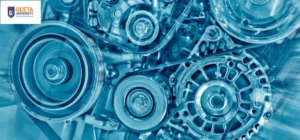An Overview of Embedded Systems and IoT
- August 31, 2024
- Geeta University
The Internet of Things (IoT) and embedded systems are revolutionizing how we connect with the digital and physical worlds in today’s technologically advanced society. These technologies are interdependent, with each one being vital to the development of smarter, more effective systems that improve our daily lives and transform a number of industries.
What IoT means:
The network of physical objects—devices, cars, appliances, and more—that are integrated with sensors, software, and other technologies to communicate and share data with other devices via the internet is known as the Internet of Things, or IoT. With the help of IoT, these “smart” things may gather, send, and act upon data, forming an intricate network of interconnected systems that can streamline workflows, improve efficiency, and yield insightful information.
What Embedded Systems Are:
Specialized computer systems called embedded systems are made to carry out particular functions in bigger mechanical or electrical systems. Embedded systems, as opposed to general-purpose computers, are specialized and frequently integrated inside devices to regulate and oversee their operation. Microcontrollers in microwave ovens, automotive engine control systems, and smart thermostat sensors are a few examples of embedded systems.
Connections Between Embedded Systems and IoT:
Many IoT devices are built on embedded systems. They supply the capability and processing power needed for gadgets to communicate online and engage with their surroundings. Essentially, embedded systems give devices the ability to be “smart” and involved in the Internet of Things. An embedded system, for instance, is used by a smart thermostat to track temperature, manage heating and cooling, and establish Internet of Things connections with other gadgets and online services.
Importance and Embedded Systems’ Impact:
The confluence of embedded systems and IoT has significant implications across multiple industries, ranging from healthcare and industrial automation to smart cities and households. IoT makes it possible to connect systems and devices, which improves user experiences, makes resource management more effective, and provides data-driven insights for better decision-making. Conversely, embedded systems guarantee the dependable and effective operation of these gadgets, spurring innovation and revolutionizing several sectors.
The IoT’s Foundations
IoT components:
Devices/Sensors: In an Internet of Things system, devices and sensors serve as data entry points. Sensors gather data from the physical environment, such as light, motion, humidity, and temperature, and then transform it into processable digital data. Simple temperature sensors to intricate machines with several sensors and actuators are examples of devices.
Connectivity: The infrastructure for communication that permits devices to send and receive data is referred to as connectivity. This can include cellular networks, Bluetooth, Zigbee, Wi-Fi, and other communication protocols. A number of criteria, including data transfer requirements, battery consumption, and range, influence the choice of connectivity.
Data Processing: To obtain valuable insights, data processing entails evaluating the information gathered by sensors. This might happen in the cloud or at the edge, close to the devices. While cloud processing offers longer-term storage and more complex analysis, edge processing provides for real-time analysis and speedy answers.
User Interface: Users communicate with Internet of Things systems through the user interface. Web dashboards, smartphone apps, and voice-activated assistants are a few examples of this. Users can access data, settings, and insights from their IoT devices using the interface.
Intellectual Property:
Three layers normally comprise an IoT architecture:
Perception Layer: This layer is made up of gadgets and sensors that collect environmental data.
Network Layer: Using a variety of connectivity protocols, this layer enables communication between devices and the central processing unit.
Application Layer: This layer facilitates user interactions by processing and analyzing data to produce insights that may be put to use.
Norms and Protocols for Communication:
Interoperability and effective data exchange are made possible by a number of protocols and standards that are used in IoT connectivity. Message Queuing Telemetry Transport (MQTT), Constrained Application Protocol (CoAP), and HTTP/HTTPS are a few popular protocols. For cellular IoT, standards such as IEEE 802.15.4 and 3GPP guarantee interoperability and performance across various networks and devices.
Overview of Embedded Systems
Explanation and Qualities:
Embedded systems are computer systems created specifically for specialized tasks inside bigger systems. Embedded systems, in contrast to general-purpose computers, are frequently used in real-time contexts and are specialized for particular activities. Embedded systems are known for their dependability, effectiveness, and real-time performance.
Embedded System Components:
Microcontrollers: The central processing units (CPUs) of embedded systems are called microcontrollers. For specialized, small-scale applications, they combine a CPU, memory, and input/output peripherals into a single chip. Microcontrollers are devices that run software programs and regulate an embedded system’s actions.
Sensors and Actuators: Sensors gather information from their surroundings, and actuators act on that information once it has been processed. For instance, in a smart irrigation system, sensors gauge the moisture content of the soil, and actuators use this information to regulate the watering schedule.
Communication Modules: Communication modules provide the connection and data exchange between embedded systems and other systems. These modules enable Bluetooth and Wi-Fi as well as a number of wireless communication protocols, including SPI, I2C, and UART.
Embedded System Types:
Embedded Systems in Real Time: These systems are made to react to events in a precise amount of time. Industrial automation and automobile control systems are two examples.
Standalone Embedded Systems: Once installed, these systems function alone and don’t need any external connections. Microwave ovens and digital watches are two examples.
Networked Embedded Systems: These systems are able to communicate with other systems or devices because they are linked to networks. IoT sensors and smart home appliances are two examples.
Systems for Real-Time Operations (RTOS):
Specialized operating systems called RTOS are made for real-time applications where predictability and timeliness are essential. They offer functions like resource management, interrupt handling, and task scheduling to make ensuring that jobs are completed within predetermined time limits. VxWorks, QNX, and FreeRTOS are a few RTOS examples.
IoT Use Cases and Applications
Smart Houses:
Home Automation: The Internet of Things allows smart home appliances to automate functions like heating, lighting, and security. For instance, while smart locks offer remote access management, smart thermostats can modify temperatures in response to occupancy patterns and user preferences.
Energy Management: By tracking and controlling energy use, IoT can optimize energy utilization in homes. Energy management programs and smart meters can monitor power consumption and make recommendations for ways to lower energy expenses.
Smart Cities:
Traffic Management: Sensors and cameras are used by IoT-based traffic management systems to monitor traffic flow and improve traffic signals. This can lessen traffic, increase traffic safety, and boost the effectiveness of transportation as a whole.
Environmental Monitoring: Internet of Things gadgets are capable of keeping an eye on environmental factors including water and air quality. In order to enhance urban living circumstances, this data assists environmental organizations and city planners in making well-informed decisions.
Medicine:
Remote Monitoring: IoT devices make it possible to remotely monitor health metrics—like blood pressure, glucose levels, and heart rate—for patients. This enables medical professionals to monitor patients’ symptoms in real time and take appropriate action when needed.
Wearable Health Devices: Smartwatches and fitness trackers are examples of wearable technology that provide consumers information about their fitness and overall health. These gadgets monitor sleep habits, activity levels, and other health parameters.
IoT in Industry (IIoT):
Predictive Maintenance: Internet of Things sensors track the functionality of machinery and identify wear or malfunctions. Using this data, predictive maintenance systems may forecast when repair is required, cutting downtime and increasing the life of the equipment.
Process Optimization: IIoT systems provide real-time production data, which helps to optimize industrial processes. parameters, the state of the equipment, and the stock levels. This data contributes to increased productivity, decreased waste, and improved product quality.
Farming:
Precision Farming: By offering data on crop health, weather patterns, and soil conditions, IoT devices facilitate precision farming. Utilizing this information can help farmers optimize their methods for fertilization, watering, and planting.
animals Monitoring: IoT devices are capable of keeping an eye on the well-being and conduct of animals. Wearable sensors enable farmers better manage their herds by monitoring vital signs, activity levels, and feeding habits.
IoT Embedded Systems
IoT Embedded Systems Role:
IoT devices require embedded systems because they offer the essential processing power, data management, and control features. They allow devices to communicate with other devices or cloud services, process data, and engage with sensors. For IoT solutions to function as a whole, embedded systems’ dependability and effectiveness are essential.
IoT Devices Using Embedded Systems:
Smart Thermostats: Voice assistants and mobile apps can interact with embedded systems in smart thermostats, which also operate heating and cooling systems and temperature sensors.
Wearable Fitness Trackers: Activity monitoring and health insights are provided to users via embedded systems in fitness trackers that process data from accelerometers and heart rate monitors.
Industrial Sensors: Embedded systems in industrial sensors track environmental factors and equipment performance, sending data for analysis to central control systems.
IoT Embedded System Design: Obstacles and Solutions:
Resource Constraints: Memory and computing power are frequently scarce in embedded systems. Code optimization, the use of effective algorithms, and the use of hardware accelerators are some solutions.
Power Consumption: Since a lot of Internet of Things devices run on batteries, energy-efficient design is necessary. Power consumption problems can be addressed with the aid of strategies like energy harvesting, sleep modes, and low-power components.
Security: It is essential to guarantee embedded systems’ security. Using encryption, secure boot, and routine software updates to guard against vulnerabilities are some solutions.
Internet of Things Security and Privacy
Problems with Security:
Data Privacy: Sensitive data is collected by IoT devices, and protecting its privacy is a top priority. Data breaches have the potential to damage user privacy and reveal personal information.
Device Security: Weak security protocols frequently leave IoT devices open to attack. Device security entails guarding against infection, manipulation, and unwanted access.
Optimal Techniques for Protecting IoT Devices:
Encryption: To guard against interception and unauthorized access, encrypt data being transferred between devices and cloud services.
Authentication and Authorization: Put robust authentication procedures in place to guarantee that only approved individuals and devices are able to access and manage Internet of Things systems.
Regular Updates: To fix security flaws and defend against new attacks, keep your software and firmware up to date.
New Technologies and Solutions:
Blockchain: By offering a decentralized, impenetrable ledger for data transactions, blockchain technology can improve Internet of Things security. This can stop unwanted data modification and increase openness.
Artificial Intelligence and Machine Learning: These two fields of study have the potential to find trends and abnormalities that point to potentially harmful activities, enabling real-time security threat detection and response.
Next Innovations and Trends
AI and Machine Learning Integration:
Advanced data analysis and decision-making are made possible by the IoT’s combination of AI and machine learning. Large amounts of IoT data can be processed by AI algorithms, which can then be used to find patterns in the data and forecast or recommend actions. By doing this, IoT systems are able to perform in a more intelligent and independent manner.
IoT and Edge Computing:
Computation and data storage are pushed closer to the point of data production through edge computing. IoT systems can improve real-time decision-making, minimize latency, and use less bandwidth by processing data at the edge. By sending less data to the cloud, edge computing also improves data privacy.
5G and the Internet of Things:
IoT is about to undergo a transformation with the advent of 5G networks, which will offer better bandwidth, reduced latency, and more device density. New use cases and applications will be made possible by this, including massive machine-type communications (mMTC) for smart cities and ultra-reliable low-latency communications (URLLC) for autonomous cars.
IoT Security Using Blockchain:
IoT data and transaction management is made secure and decentralized by blockchain technology. Blockchain can improve the data integrity, traceability, and security of Internet of Things systems through the use of distributed ledgers and smart contracts.
Results
To sum up, the Internet of Things (IoT) and embedded systems are leading the way in technological innovation, propelling progress in a multitude of fields. Embedded systems supply the necessary processing power and control for these devices, while the Internet of Things (IoT) links the digital and physical worlds to enable smarter and more efficient systems. The potential and influence of IoT will be further amplified by the incorporation of AI, edge computing, and sophisticated communication networks such as 5G, as technology advances. We can fully realize the potential of IoT and embedded systems and pave the way for a more intelligent and connected future by tackling issues with security, privacy, and resource limitations.

Admission Open 2024-2025
For Your bright Future
Tags
Related Posts

How to find the correct stream after the 10th standard? – Geeta University
Are you confused about which stream to choose after 10th? What is the best stream of the future? What should you learn after Class 10th? Almost all students sails in the same boat. These are the top questions asked by

Best Courses After 12th Science, Future, Scope and Career Prospects – Geeta University
One question that keeps popping up in the minds of all 12th grade students is how to choose a safe, secure and fruitful career option. The task of choosing the right path can be difficult for Grade 12th students specially

Best Courses After 12th Arts, Future, Scope and Career Prospects – Geeta University
It is important to choose the right subject for your graduation because it is probably the most important time for your study. Making the right decision today will put you on the path to school and professional success by enrolling
